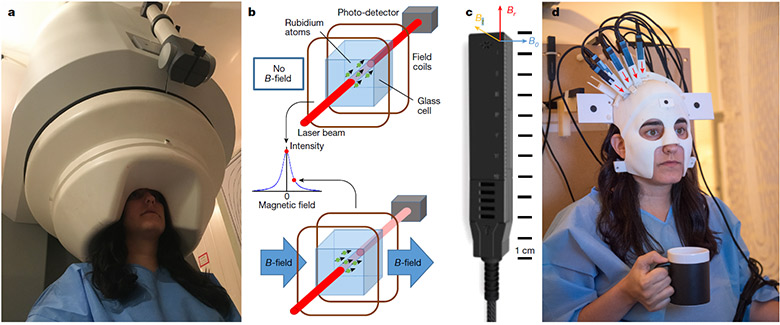The world's first portable MEG scanner

Left: the usual 275-channel cryogenic MEG system. It weighs about 450 kg, fixed in one position and cumbersome, and a person must be stationary for a long time relative to the sensor unit. Right: OPM-MEG prototype helmet. It weighs 905 g and is configured so that the sensors are directly adjacent to the surface of the head (in this prototype, they cover only the right sensorimotor cortex). A person can freely move his head.
Magnetic encephalography (MEG) is a technology that allows to measure and visualize magnetic fields arising from the electrical activity of the brain. For the fields, high-precision superconducting quantum interferometers (SQUID sensors) are used.
The use of superconductors in itself suggests that MEG installations must be cumbersome and expensive. And there is. More precisely, it has been so far until a group of researchers from the University of Nottingham (UK), University College London, and QuSpin presented the world's first portable MEG scanner .
First you need to briefly explain why MEG scanners are so cumbersome. The fact is that as a result of the electrical activity of the brain, extremely weak magnetic fields are generated, and only a very sensitive instrument can register them. That is why superconducting quantum interferometers are used here, which distinguish between a field strength of several femtotesl. These sensors operate at ultra-low temperatures, so they are in liquid helium, and between them and the patient's skull is placed vacuum space. Any movement of the head greatly degrades the quality of the data: even moving by 5 mm can make the measurement results unsuitable. The distance from the sensors to the head is also critical, because the signal strength depends on the square of the distance. All of the above not only complicates research,
The world's first portable scanner OPM-MEG radically changes the situation. Of course, you cannot walk with him on the street, but even in this form, he significantly expands the possible field for experiments. For the first time, scientists can fully scan the brain of active children and people with movement disorders. In addition, fundamentally new research becomes possible. For example, research in the field of spatial navigation, which were extremely difficult when a person had to be in a stationary position. Now you can finally see what happens in the human brain during natural communication with other people, including the opposite sex.

In the new helmet, the sensors are fixed relative to the human brain, and not relative to the stationary machine. Optical-pumped magnetometers (OPM) manufactured by the American company QuSpin are integrated directly into the surface of the helmet and connected to the system to suppress external magnetic fields. To repeal the influence of the Earth’s magnetic field, the researchers used a set of biplanar electromagnetic coils. They generate a magnetic field, exactly the opposite of the earth, in order to nullify its influence on measurements. A big limitation is that the patient cannot go beyond this protected field: an invisible cube with a border of about 40 cm.
Accuracy of measurements requires that the helmet is ideally attached to the skull and face of the patient, so for each person the product will have to be made individually. It is made using 3D printing.
Scientists have checked the accuracy of measurements in the OPM-MEG helmet in comparison with traditional magnetic encephalography. During the experiments, patients performed the same task (raising a finger) in different scanners - and the results were the same. In addition, for the first time, researchers studied brain activity in tasks that, in principle, could not be investigated before. These are tasks that require mobility, including moving the head. For example, drink water from a mug or tamp the ball on a racket.
Despite the remaining limitations, the first MEG portable scanner will make a significant step forward in the study of the human brain. It is interesting how far progress will go in this direction when the first full-fledged MEG interfaces for communication with a computer appear. Virtual reality games and applications that respond to brain activity and “understand” what gives a person pleasure and what scares him - and adapt to a specific player. Probably MEG-MEG wireless sync channels between people will approximately correspond to what our ancestors called telepathy.
The scientific article was published on March 21, 2018 in the journal Nature (doi: 10.1038 / nature26147, pdf ).
